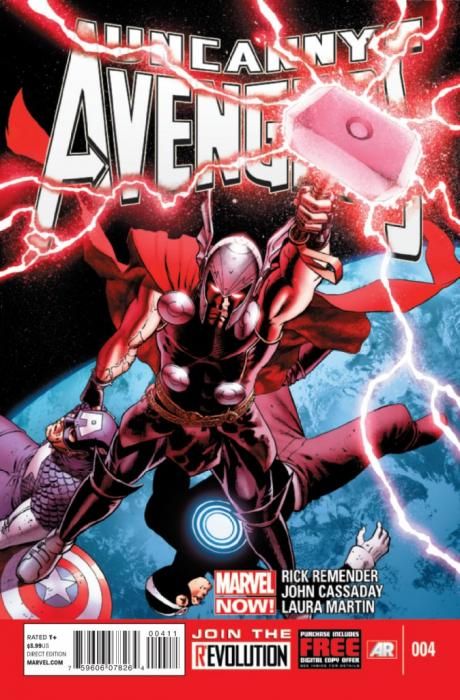Despite being the "flagship" Marvel NOW! book, it's fair to say "Uncanny Avengers" hasn't been quite the hit Marvel was probably hoping for. Reader response seems lukewarm, and delays with John Cassaday's art have sapped some of the title's momentum. Nonetheless, it's got one of the industry's top superhero writers in Rick Remender, and "Uncanny Avengers" #4 suggests that the series isn't ready to be written off just yet -- but mainly because of where it's going rather than where it is.
In recent issues, Remender tried out the use of third-person omniscient narrative captions -- a technique so far out of fashion that the last time anyone used them in a mainstream superhero book, Alan Moore was still working at DC. The problem is that omniscient narration is mainly useful for filling in the gaps between panels in "compressed" stories. When a fight scene is stretched across most of the issue, there's little need for further elaboration -- they illuminate the characters' thoughts and actions, but too often in a wholly uninteresting "tell, don't show" manner. It's an interesting experiment, but it's hard to call it entirely successful.
Remender's biggest strength, however, lies in tone. This is a series that takes the "Uncanny" nomenclature straight to heart, with a deeply weird vibe throughout, but it also shifts expertly towards a more raw emotional state when necessary. When readers see Wolverine healing from his beating unusually slowly, Remender constructs the scene such that readers realize he's still hurt by Xavier's death and the physical damage is a manifestation of his emotional pain.
Cassaday's artwork, however, seems like a poor bedfellow for Remender's particular brand of strangeness, more suited to realism. His figures also lack the polish and character found in his run on "Astonishing X-Men," while the widescreen storytelling which once defined his new approach seems to have become a default fallback position, frequently unexciting and deployed without discretion.
Still, the last couple pages suggest Remender has bigger ideas about what "Uncanny Avengers" will be, and his "Uncanny X-Force" run proves he has the chops to deliver storytelling on that larger scale. When paired with a more appropriate (and faster) artist, it's likely the book will improve. There's an audacity to the ending that has to be admired and at the very least, it's earned a pass for yet one more issue. It's hard not to feel that with the difficult first arc out of the way, "Uncanny Avengers" will finally start its upward trend.

